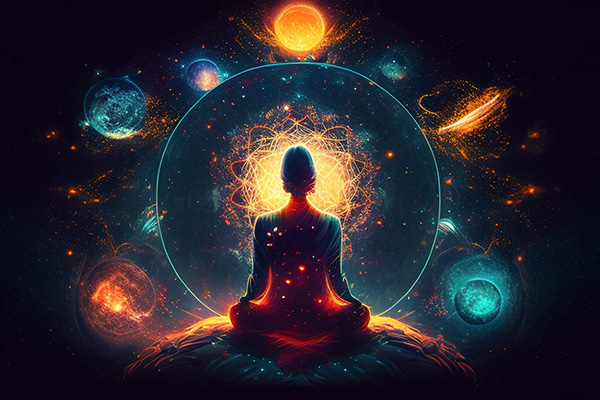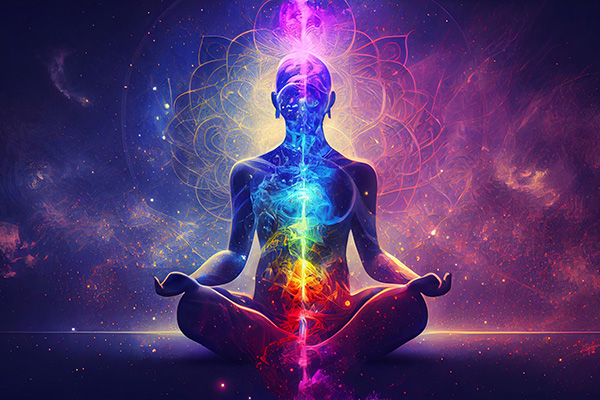sound therapy
End Your Day With A Restorative Evening Ritual
 How we end our days is just as important as how we begin them. Yet this time of the day is often overlooked as an opportunity to promote our personal and spiritual well-being.
How we end our days is just as important as how we begin them. Yet this time of the day is often overlooked as an opportunity to promote our personal and spiritual well-being.
Especially when navigating stressful situations or busy schedules, being intentional about how we transition into rest can significantly improve the quality and restorative nature of our downtime.
Creating a simple, personalized nighttime routine allows us to check in with ourselves and make sure we’re taking care of our mind, body, and spirit. It helps relieve the stress of the day and sets the tone for a restful night’s sleep.
There are countless ways to create an evening ritual or routine that resonates with your spirit. The important thing is that your practice feels authentic and meets your needs. It only takes a few simple steps to create a daily practice that helps us release the stress of the day.
Whatever practice you choose, make sure it works with your schedule and is relaxing, rather than feeling like it creates more daily tasks to complete.
Choose activities that help you relax and that you look forward to. Whether it’s journaling, listening to soothing music, or lighting a candle, choose activities that help you intentionally transition from the busyness of the day to the calm of the night.
Many people complain that they don’t have enough time in their day. For them, a daily spiritual routine is a frivolous luxury they cannot afford to waste time on, yet these same people often spend hours each night binge-watching television or endlessly scrolling through their phones. This modern paradox highlights how easily we prioritize mindless distractions over meaningful self-care. By consciously reclaiming even a fraction of this time, we can nurture our spiritual well-being every evening in a way that renews our body, mind, and spirit far more effectively.
The Soulful Practice Of Kirtan Chanting
 An ancient spiritual practice less known in the West has transformed my spiritual routine in recent years. It is known as kirtan a beautiful form of devotional chanting that originated in ancient India.
An ancient spiritual practice less known in the West has transformed my spiritual routine in recent years. It is known as kirtan a beautiful form of devotional chanting that originated in ancient India.
The term “kirtan” comes from Sanskrit and means “narrating, reciting, telling, describing” of an idea or story, particularly in a religious context. This enchanting practice weaves together music, meditation, chanting, and a deep sense of spiritual expression.
Kirtan is a central practice in the Bhakti Yoga tradition, which emphasizes love and devotion to a personal deity. It involves the repetitive chanting of mantras and divine names, traditionally in Sanskrit, accompanied by musical instruments such as the harmonium, tabla, and cymbals.
Traditionally, kirtans focus on chanting the names of deities like Krishna, Rama, or Sita. The kirtan leader sings a line and the congregation responds, creating a rhythmic and melodic interplay that is both meditative and invigorating.
While Kirtan remains rooted in its spiritual origins, it has gained global popularity beyond India and the Bhakti tradition. As the practice of yoga has boomed worldwide, kirtan too has seen an immense rise in popularity. It’s a testament to the universal appeal and transformative power of this captivating practice.
Kirtan events and gatherings are known for being welcoming and inclusive, focusing on the shared experience of chanting rather than strict religious adherence. Unlike the typical musical experience in spiritual settings, kirtan invites everyone to participate in a soulful, call-and-response chanting that creates a profound connection to the divine and brings people closer together.
Spiritual Practices To Improve Your Mental Health
 Mental health has become a critical focus for many in recent years. While traditional methods such as counseling, therapy, and medication are essential in addressing mental health issues, the mental health benefits of spirituality are often overlooked.
Mental health has become a critical focus for many in recent years. While traditional methods such as counseling, therapy, and medication are essential in addressing mental health issues, the mental health benefits of spirituality are often overlooked.
Everyone’s mental well-being is affected at some point by the challenges of modern life. It is common to feel out of balance when our world seems to be spinning out of control, or when it seems that we are not getting the things we most want in our lives.
Most people don’t realize that spiritual connection is essential to our mental health and facilitates well-being on all levels. Because mental health issues have such a low and heavy vibration, they make it difficult and sometimes impossible to feel the presence of God, Source, Spirit, the Divine in our lives.
But by working daily to establish a strong connection with your spirit guides and higher source, you are taking a powerful step toward freeing yourself from the grip of these inner demons and dark energies.
Spirituality in its various forms is a powerful way to connect with yourself and the world, fostering a deeper sense of inner peace and purpose for a more balanced and fulfilling life. Research clearly shows that various spiritual practices can significantly improve mental health. These practices offer complementary benefits to traditional mental health treatments, promoting emotional resilience, stress reduction, and overall psychological well-being.
Personally, I have found that spiritual practices such as prayer, meditation, and journaling give me greater access to guidance and support from the spirit realm and my guides. Our guides are a wonderful source of healing, guidance, and direction. Getting in touch with our guides can actually help us get out of a funk because they have the ability to set us free and empower us on every level.
Energy Self-Care Strategies For Empaths And Sensitives
 Empaths and highly sensitive people (HSPs) often feel drained by other people and certain environments due to their inherently sensitive nature and the way they interact with the world around them.
Empaths and highly sensitive people (HSPs) often feel drained by other people and certain environments due to their inherently sensitive nature and the way they interact with the world around them.
We face unique physical, mental, emotional and spiritual challenges because of our innate ability to deeply feel and absorb the thoughts, emotions and energies of those around us. While our sensitivity is a blessing and a gift to the world, it can also become a curse through overwhelming experiences of empathic overload and energy depletion.
Energetic self-care is therefore of paramount importance to the sensitive person. Every empath or HSP should adopt a daily routine of energetic self-care practices designed to cleanse, protect and rejuvenate their aura or personal energy field.
Mastering these practices is not only beneficial to our health and well-being, it’s essential for maintaining holistic balance, protecting our mental health in particular, and nurturing our deep connection to the world and those around us.
As empaths and HSPs, we can manage our energy more effectively by employing several strategies that help us maintain our energetic well-being, while navigating a world that can often feel overwhelming. The following are essential tools and strategies that can empower empaths and HSPs to thrive in their sensitivity and turn their deep empathy into their greatest strength through effective energetic self-care:
The Anchoring Vitality Of The Root Chakra
 The chakras play a pivotal role in our energetic well-being. These energy centers, rooted in ancient Eastern philosophies, govern various aspects of our physical, emotional, and spiritual functioning and health.
The chakras play a pivotal role in our energetic well-being. These energy centers, rooted in ancient Eastern philosophies, govern various aspects of our physical, emotional, and spiritual functioning and health.
At the very base of this intricate energy system lies the root chakra, an energetic foundation that holds the key to our sense of security, stability, and connection to the world around us.
The root chakra, also known as the base chakra or muladhara in Sanskrit, is the first of the seven main chakras at the base of the spine. Its significance cannot be overstated, as it is the energetic anchor for the entire chakra system. This energy center is associated with red, symbolizing vitality, strength, and the life force that flows through us.
At its core, the root chakra is linked to our most primal instincts and survival needs. Its activation is crucial for establishing a solid foundation for a balanced and fulfilling life. When the root chakra is in harmony, it fosters a sense of security, grounding, and a deep connection to the physical world.
One of the primary functions of the root chakra is to address our basic survival needs, including food, shelter, and a sense of safety. When this chakra is balanced, we feel secure in our environment, enabling us to navigate life with confidence and stability. On the contrary, an imbalanced root chakra may manifest as fear, anxiety, or a constant sense of insecurity.
Chakra Balancing Is An Essential Self-Care Practice
 I recently attended a very informative talk given by a couple who are both energy healers. The husband is also a respected medium in our area. The topic was the chakra system and how to use it in an energy healing practice.
I recently attended a very informative talk given by a couple who are both energy healers. The husband is also a respected medium in our area. The topic was the chakra system and how to use it in an energy healing practice.
As a psychic practitioner, I already know a lot about the chakra system, but I am always open to other people’s perspectives and possibly even learning something new. I think it is important in any profession to keep an open mind and to have the desire to learn as much as possible. You are never too old, too wise, or too experienced to gain new insights!
So, I was pleasantly surprised that this talk turned out to be a wonderfully informative experience. In particular, the session reminded me of the importance of keeping one’s chakra wheels ‘in tune’, especially if one is in the business of healing or doing readings.
Clearing and balancing the chakras is vital because when a chakra is deprived of harmonious, free-flowing energy, it becomes unbalanced or even blocked, causing dysfunction in the organs and other mind-body functions associated with that chakra, as well as dysfunction throughout the rest of the entire chakra system.
The Basics Of Chakra Balancing
 Did you know that we have two bodies? Not only do we have a physical body, but we also have a light body.
Did you know that we have two bodies? Not only do we have a physical body, but we also have a light body.
Our physical body is our visible and tangible form, made up of bones, muscles, organs and other tissues. It is our physical manifestation in this earthly realm and is subject to the laws of physics and biology.
Our light body, on the other hand, is the subtle energy system underlying to the physical body. It is the energetic bridge between our physical body and our higher, soul existence beyond the physical body. The light body is invisible to the naked eye and is subject to metaphysical or universal laws.
The concept of the ‘body of light‘ or ‘luminous body’ is found in various esoteric, occult, and mystical teachings and is also known as the aura, human energy field, astral body, subtle body, spirit body, radiant body, sidereal body, or celestial body.
The main feature of the light body are the chakras, an intricate network of energy centers or vortices that play a vital role in our physical, mental, and spiritual well-being. According to some teachings there are as many as 114 to 88,000 chakras, but this is not a commonly accepted understanding in the fields of yoga and energy healing.